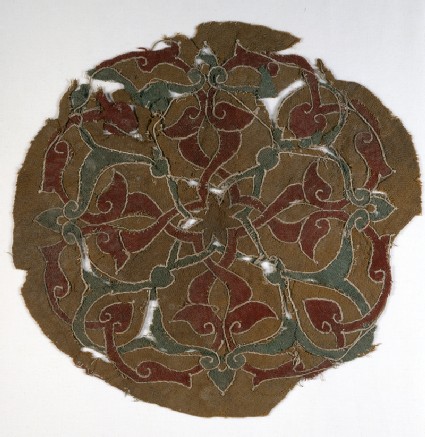Embroideries and Samplers from Islamic Egypt
A selection of 10th to 16th century embroideries from the Newberry collection at the Ashmolean by Marianne Ellis (published Oxford, 2001).

Publications online: 66 objects
- Reference URL
Actions
Roundel fragment with interlacing vines and leaves
-
Literature notes
At the centre of the roundel an 8-pointed star has been created by two interlaced cruciform designs in red and green stems, which develop into flowing curved patterns of palmettes and leaves as they move away from the centre. A remarkably similar, but simpler version of this stellar design occurs on a bowl with incised decoration from Fustat, which has been attributed to the 13th or 14th century (\/ictoria and Albert Museum, London, No. C.162-1932), proving yet again that motifs were repeated from one medium to another. What it does not tell is who was copying whom and whether cartoons existed to guide the craftsmen at this period.
The roundel is made of a type of patchwork known as 'inlay' in which pieces of cloth are cut to shape and inserted into similar pre-cut areas of ground fabric. The same process was followed with ivory or bone shapes inlaid into wood, popular at this time in Egypt. In Iran colourful textiles have been made in inlaid patchwork since at least the 17th century and are generally referred to as Resht work. The technique was much used for hangings and further decoration was added by lines of tamboured chain stitch to cover the joins of the shapes. Here thick white linen thread has been couched down for the same reason and clearly defines the flowing lines of the design. -
Details
- Associated place
-
Near East (place of creation)
- Date
-
14th century (1301 - 1400)
Mamluk Period (1250 - 1517)
- Material and technique
- wool, twill woven, and dyed brown, with green and red wool inlay appliqué, embroidered with white flax; with stitching, possibly in cotton
- Dimensions
-
34 x 34 cm max. (length x width)
along length/width 16 / 16 threads/cm (thread count)
ground fabric 0.1 cm (thread diameter)
- Material index
- Technique index
-
woven › twill woven,assembled › woven › twill woven,dyed,
- Object type index
- No. of items
- 1
- Credit line
- Presented by Professor Percy Newberry, 1941.
- Accession no.
- EA1984.133
-
Further reading
Ellis, Marianne, Embroideries and Samplers from Islamic Egypt (Oxford: Ashmolean Museum, in association with Greenville: Curious Works Press, 2001), no. 50 on p. 72, p. 10, illus. pp. 72-73
Barnes, Ruth and Marianne Ellis, ‘The Newberry Collection of Islamic Embroideries’, 4 vols, 2001, Oxford, Ashmolean Museum, cat. vol. ii, illus. vol. i
Location
-
- currently in research collection
Objects are sometimes moved to a different location. Our object location data is usually updated on a monthly basis. Contact the Jameel Study Centre if you are planning to visit the museum to see a particular object on display, or would like to arrange an appointment to see an object in our reserve collections.
Publications online
-

Embroideries and Samplers from Islamic Egypt
At the centre of the roundel an 8-pointed star has been created by two interlaced cruciform designs in red and green stems, which develop into flowing curved patterns of palmettes and leaves as they move away from the centre. A remarkably similar, but simpler version of this stellar design occurs on a bowl with incised decoration from Fustat, which has been attributed to the 13th or 14th century (\/ictoria and Albert Museum, London, No. C.162-1932), proving yet again that motifs were repeated from one medium to another. What it does not tell is who was copying whom and whether cartoons existed to guide the craftsmen at this period.
The roundel is made of a type of patchwork known as 'inlay' in which pieces of cloth are cut to shape and inserted into similar pre-cut areas of ground fabric. The same process was followed with ivory or bone shapes inlaid into wood, popular at this time in Egypt. In Iran colourful textiles have been made in inlaid patchwork since at least the 17th century and are generally referred to as Resht work. The technique was much used for hangings and further decoration was added by lines of tamboured chain stitch to cover the joins of the shapes. Here thick white linen thread has been couched down for the same reason and clearly defines the flowing lines of the design. -

The Newberry Collection of Islamic Embroideries
A large roundel with green and red interlaced vine and leaf appliqué on a brown ground.
White flax couching stitches are embroidered around the appliqué patterns.
Notice
Object information may not accurately reflect the actual contents of the original publication, since our online objects contain current information held in our collections database. Click on 'buy this publication' to purchase printed versions of our online publications, where available, or contact the Jameel Study Centre to arrange access to books on our collections that are now out of print.
© 2013 University of Oxford - Ashmolean Museum


